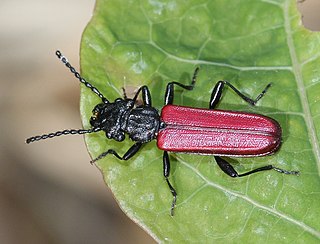
The Cucujidae, or flat bark beetles, are a family of distinctively flat beetles found worldwide under the bark of dead trees. The family has received considerable taxonomic attention in recent years and now consists of 70 species distributed in five genera. It was indicated Cucujus species are scavengers, only feeding on pupae and larvae of other insects and on other subcortical beetles such as their own. Since the Cucujidae prey on larvae of potentially tree damaging beetles that spread fungal diseases, they are considered to be beneficial to the health of living trees.
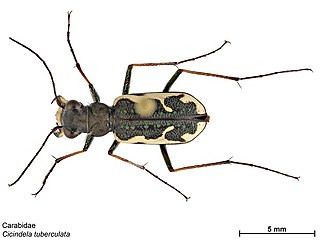
Neocicindela tuberculata is a species of tiger beetle in the family Cicindelidae, endemic to New Zealand. Its common names include common tiger beetle, moeone, and papapa, and in its larval stage penny doctor, butcher boy, kapuku, kui, kurikuri, moeone, and muremure. Neocicindela tuberculata was the first carabid beetle described from New Zealand. The species can run as fast as 5 miles per hour and are considered to be the fastest running beetles. Adult species prefer clay banks in summer and are good predators when in comes to insects.

Tree wētā are wētā in the genus Hemideina of the family Anostostomatidae. The genus is endemic to New Zealand. There are seven species within the genus Hemideina, found throughout the country except lowland Otago and Southland. Because many tree wētā species are common and widespread they have been used extensively in studies of ecology and evolution.
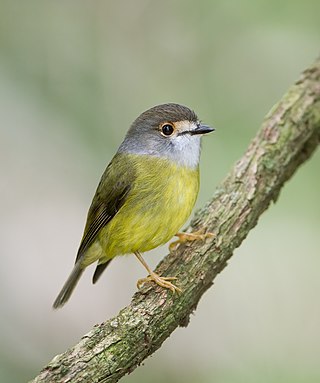
The pale-yellow robin is a species of passerine bird in the family Petroicidae. It is endemic to eastern Australia. Its natural habitat is subtropical or tropical moist lowland forests. It is a nondescript bird with grey head and olive upperparts, white throat and yellow underparts. The sexes are similar. Two subspecies are recognised: the smaller nana from North Queensland, and the larger and uncommon nominate race capito from southeast Queensland and northeastern New South Wales. It is insectivorous.

Mecodema oconnori is a large-bodied species of ground beetle that is found mainly on the western regions of the North Island, New Zealand. It is mainly found in native forest habitats, both intact and fragmented, and on the edges of pine plantations. Mecodema oconnori ranges from Otaki, Kapiti Coast to Raglan, but is also found in the Manawatu Gorge and some other eastern localities.

Orocrambus flexuosellus is a species of moth in the family Crambidae. It was first described by Edward Doubleday in 1843. O. flexuosellus is endemic to New Zealand. It has been recorded from the North Island, South Island and the Stewart Islands. The species' habitat consists of lowland to alpine grasslands.

Pericoptus punctatus is a sand scarab beetle that is endemic to New Zealand. It is a smaller and similar New Zealand scarab beetle species to Pericoptus truncatus.
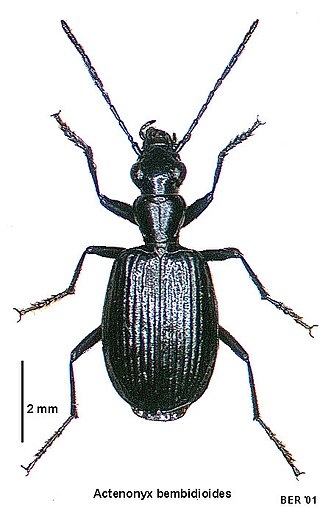
Actenonyx is a genus of beetles in the family Carabidae. At present only species in this genus is Actenonyx bembidioides. However, it has been suggested that a taxonomic revision of this genus is needed as there are two species that await description. This genus and species was first described by Adam White and is endemic to New Zealand.

Molopsida is a genus of beetles in the family Carabidae, endemic to New Zealand. This genus was first described by Adam White (zoologist) in 1846. Molopsida includes the following six species:

Megadromus is a genus in the beetle family Carabidae. There are at least 30 described species in Megadromus, found in New Zealand.
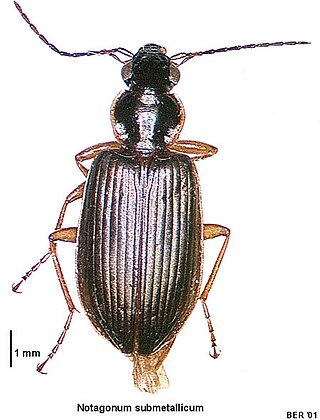
Notagonum submetallicum is a species of ground beetle in the subfamily Platyninae. It was described by Adam White in 1846.

Mecyclothorax rotundicollis is a species of ground beetle in the subfamily Psydrinae. It is endemic to New Zealand. It was described by White in 1846.

Orocrambus vittellus is a moth in the family Crambidae. It was described by Henry Doubleday in 1843. It is endemic to New Zealand. This species has been recorded in the North and South Islands, as well as Stewart Island. It prefers a habitat that consists of grasslands.

Megadromus antarcticus, also known as the “Alexander beetle”, is a member of the Carabidae family and only found in the Canterbury region of New Zealand. Megadromus antarcticus are easily recognized by their iridescent green colouration.

Tetrorea cilipes is a species of beetle in the family Cerambycidae. It was described by Adam White in 1846. It is known from New Zealand. The larvae of T. cilipes are known to make a distinct clicking sound.
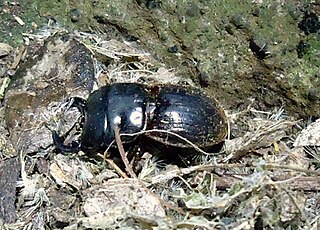
Geodorcus capito is a large flightless species of stag beetle in the family Lucanidae. It is endemic to the Chatham Islands in New Zealand.

Geodorcus sororum is a large flightless species of stag beetle in the family Lucanidae. It was discovered in 1973 by Mr. A. Wright on an expedition to Middle Sister Island/Te Awanui, one of The Sisters Islands/Rangitatahi which are part of the Chatham Islands in New Zealand. This holotype specimen is held in the New Zealand Arthropod Collection. It was first described by Beverley Holloway in 2007. The name sororum is translated from Latin to mean "belonging to the sisters".

Scolopterus is a genus of weevils from the family Curculionidae. This genus was first described by Adam White in 1846. The type species for this genus is Scolopterus tetracanthus White, 1846 by original designation. Species from this genus are found in New Zealand.
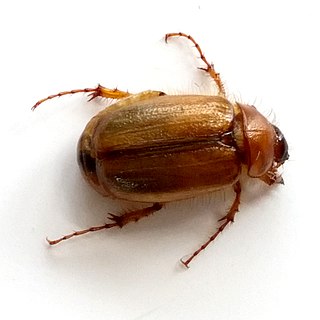
Costelytra zealandica is a species of scarab beetle found in forested areas of greater Wellington. It was originally described in 1846 by the British entomologist Adam White as Rhisotrogus zealandicus from a specimen obtained during the Ross expedition. The species is known to feed on roots of plants and trees, so is considered a pest for many farm pastures.

Megadromus speciosus is a species of ground beetle, endemic to New Zealand and of high conservation interest.



















